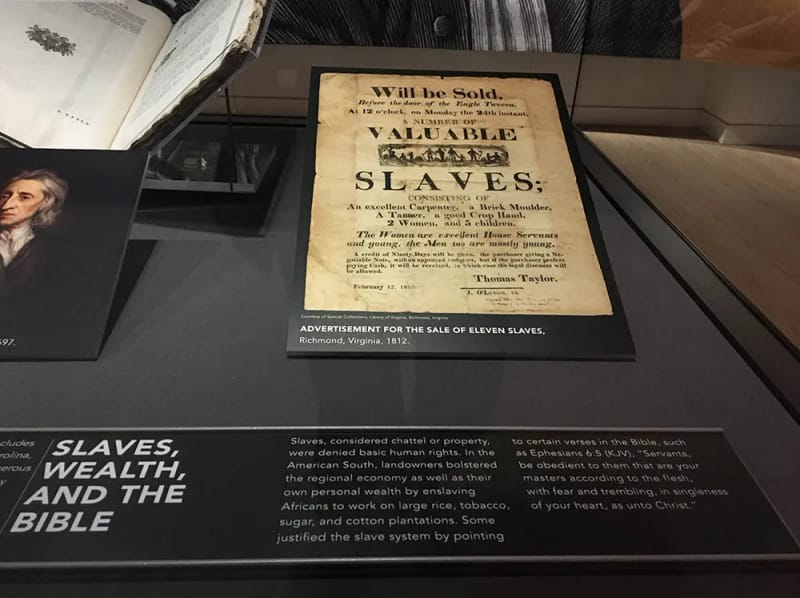The Slave Bible

Slave Bible Exhibit Examines Use of Religion in during the enslavement of the so call black, Afro Caribbean people, Arawaks, Caribs, Native Indians, Central America, North and South American Native Indians Enslave to Spain and Portugal, Islands of the Caribbeans, Africa, Hebrew Israelites from Jerusalem, Asia the Negroes of the 12 Tribes, Greek speaking Jews, GENTILES of the Northern kingdom of Israel (Ephraim, and the other Tribes of Israel), and all of the REMNANT of the Holy Peculiar people of the Most High Inheritance, who are called to be SAINTS, and they are SCATTERED among the heathens to the four corners of the earth to this very day in their CAPTIVITIES (Baruch 3:8 Kjva).

Washington – On Wednesday, November 28th, Museum of the Bible will unveil its newest exhibit,The Slave Bible: Let the Story Be Told, which spotlights a rare artifact – an abridged version of the Bible that was used by British missionaries who worked with enslaved Africans in the Caribbean. The exhibition, which will be on display through April 2019, provides insight into a dark moment in history in which the Bible and religion were used for imperial and economic gain.
An abridged version of the Bible, which became known as the Slave Bible, was published in London in 1807 and used by some British missionaries to convert and educate enslaved Africans about Christianity – while instilling obedience and preserving their system of slavery throughout their colonies. British colonists created the Slave Bible by removing sections – and in some cases entire books – from the Bible out of fear that the full Bible would promote rebellion among slaves or offer hope for a better life. The story of the Exodus from Egypt and the book of Revelation were stripped from this truncated version of the bible. The results were drastic. A typical Protestant edition of the Bible contains 66 books, a Roman Catholic version has 73 books and an Eastern Orthodox translation contains 78 books. By comparison, the astoundingly reduced Slave Bible contains only parts of 14 books.

“The Slave Bible was used to push a specific message to enslaved NEGROES, the Hebrew Israelite people. But this important artifact raises questions about much more than just this moment in history of human enslavement and Roman Catholic Christianity missions.
The enslavement of the Children of Israel by the Edomites (Caucasians) was done intentionally, and by prophesy, this nation, the light bearer, the symbol of the "eagle", would be the fierce nation (Deuteronomy 28:49-51) that would come against the Hebrew Israelite with the sword, and would show no regards, and no mercy to the children of the Most High.
Slave Bible: Remove Pages of the Original Holy Scriptures belonging to the Hebrew Israelite Nation (12 Tribes of Israel - today, they who called Blacks, African Americans, West Indians, Caribbean Islands, Africans, Black Asians, Central Americans, native Indians, and so on).
Some examples of texts omitted from the Slave Bible include:
Exodus 21:16 - “And he that stealeth a man, and selleth him, or if he be found in his hand, he shall surely be put to death.”
Galatians 3:28 - “There is neither Jew nor Greek, there is neither bond nor free, there is neither male nor female: for ye are all one in Christ Jesus.”
Jeremiah 22:13 - “Woe unto him that buildeth his house by unrighteousness, and his chambers by wrong; that useth his neighbour’s service without wages and giveth him not for his work.”

For African Americans, the book of Exodus is a cultural touchstone and continues to be exceedingly influential. The story of the suffering of Israelites as Egyptian slaves and their deliverance spur comparisons of the capture of Africans, the experiences of African Americans in the United States and their hope for a better tomorrow through emancipation and civil rights legislation.
The Slave Bible: Part One
“I urge people of faith to see the Slave Bible exhibit, which provides an important historical view on how religion was distorted for man’s profit.
The Slave Bible: Part two
While the abridged Bible was used as a book of oppression, the Bible today, indeed, is a book of freedom and hope for all communities, across the globe,” said Reverend Matthew Watley, Executive Minister of Reid Temple in Washington, D.C.
The Slave Bible: Part Three
The exhibit is presented in coordination with Museum of the Bible partners Fisk University, and the Center for the Study of African American Religious Life at the Museum of African American History and Culture.
The Slave Bible: Part Four
Throughout the coming months, Museum of the Bible will hold a series of cultural events and panel discussions with clergy, historians, educators and thought leaders to highlight the artifact and its impact on religion today.
The Slave Bible: Part Five
The Slave Bible is a rare artifact with an exceptionally powerful accounts that was perpetrated to this day by the so call white race, so call white man, the Caucasians (Edom, Idumea, Edomites). This exhibits at the museum offers all to see the atrocities (i.e. mass murder, genocide, burning, lynchings, violent crimes, racial hate crimes, raping men, women, and children, slaughter of millions of native Indians, and etcetera) done to the people of the Most HIGH. The opportunity to explore and examine the truth about the Slave Bible’s missionary origins and its evil use among enslaved SAINTS of the Most HIGH (the Hebrew Israelites, the Northern and Southern Kingdom) who the so call white man enslaved in the British West Indies, and other French, Dutch, Spain, Portugal, Great Britain.


